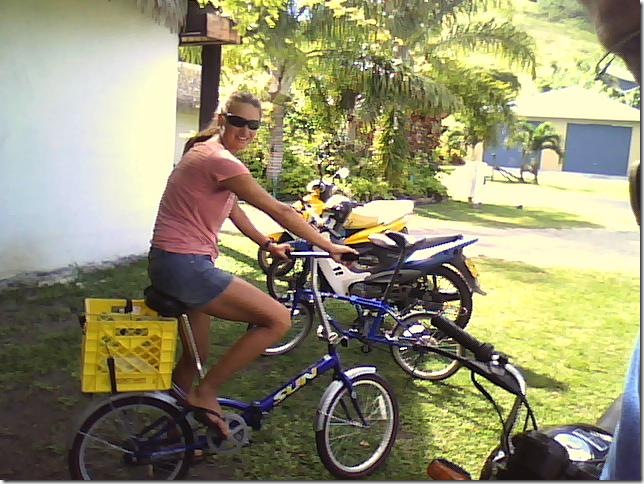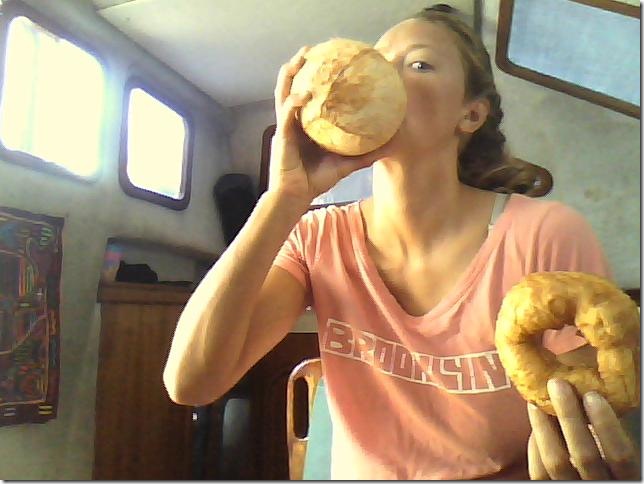We’re finally leaving Aitutaki today after a very enjoyable stay. We completed preparations yesterday. There’s a large rain water cistern not too far from the boat, so I lugged 84 gallons of water 12 gallons at a time while Lauren transferred the water into the tanks. We haven’t filled the tanks for a couple of weeks and have done a fair amount of laundry in that time, so we’re still doing OK on water usage. We’ve been doing laundry by hand since we left the Galapagos and are getting used to it, but we’re looking forward to the possibility of a reasonably priced laundromat in New Zealand.
This is the first place we’ve been where it’s technically prohibited to bring trash ashore, but we did it anyway, as most of it was stuff from Aitutaki, and all the other cruisers were using the trash barrels in the port area.
When we checked out, we found out that departure tax is $55 NZ per person, so the total cost for all of the formalities has come out to $345 NZ (about $240 US), which is more than we’d anticipated, but without the large amount of French funding present in French Polynesia, it is understandable. In general, the people seem to be about as well off here as they are in French Polynesia, even without the subsidies. One of the noticeable differences is that people drive a lot of scooters instead of the new 4×4 trucks that were everywhere in French Polynesia. We’ve also noticed a lot more gardening or farming on both a small and medium scale.
 Our “nice push-bikes” as the locals call them alongside the local conveyance
Our “nice push-bikes” as the locals call them alongside the local conveyance
I also had a chance to get my ear checked out again, this time by a very busy Chinese doctor in the local hospital at the top of the hill. He confirmed that I do have some hearing loss in the left ear but said that the inflammation was gone and it looked perfectly healthy. He suspected a blockage somewhere that should take care of itself eventually. Total cost — $0, free. That was nice. He was also the one person we’ve met on the island who didn’t have a thick Kiwi accent. Cook Islands Maori is clearly the first language of the natives, but they also speak English with a thick Kiwi accent. It’s still a bit strange, but we’ll be getting used to it. As they enjoy New Zealand citizenship, there are at least as many Cook Islanders in New Zealand as there are in the Cook Islands themselves.
The outboard propeller is still a problem. The rubber bushing that’s designed to break if you hit something is broken on the propeller we left with, and the old prop that was on the boat makes a bad slipping sound in anything that’s much above idle, so we’re left with idle speed only for a while. Hopefully that will get us by until we can remedy the situation in Tonga or New Zealand. The boat repair list is gradually getting longer as the days go by. Yesterday I was telling Silvio from Matajusi that on our 20 year old boat, something breaks every other day though most of the time it’s not serious. He just laughed. He has a virtually new boat and said that something breaks twice a day. Repairs and keeping the boat running really are a big part of the challenge of long-distance cruising. We both agreed that with the expense and difficulty of making repairs out here, instead of performance, the sailing philosophy of cruising is centered around not breaking or wearing anything out.
The upcoming passage looks like it’s not going to be our favorite. The first half is going to have very light winds (less than 10 knots), so we’ll be inching along or motoring. One of the boats that left yesterday was visible for so long that they couldn’t have been doing more than 2 knots. We should get some more wind on the second half of the passage, but the seas will be big again. We’re well into the South Pacific Convergence Zone (SPCZ), which is an area in the western Pacific where the typical tradewinds weather gives way to less predictable weather that can include light winds as well as strong winds from atypical directions. Light winds are better than strong winds from the west, so we’re actually not unlucky.
We’ve decided to skip Palmerston and head for Beveridge Reef. Palmerston is an interesting story, so we’ll try to tell it briefly in a blog during the passage, but Beveridge Reef is less of a detour and promises some incredible snorkeling and diving. It’s just a reef in the middle of the ocean — no land or people. It’s in an oval shape and has a pass with good anchoring inside, and we’ve heard the coral is amazing. The conditions should be good when we get there, so we’re hoping for a memorable stop.
 Last breakfast in Aitutaki: Local no-icing donut and coconut water
Last breakfast in Aitutaki: Local no-icing donut and coconut water

